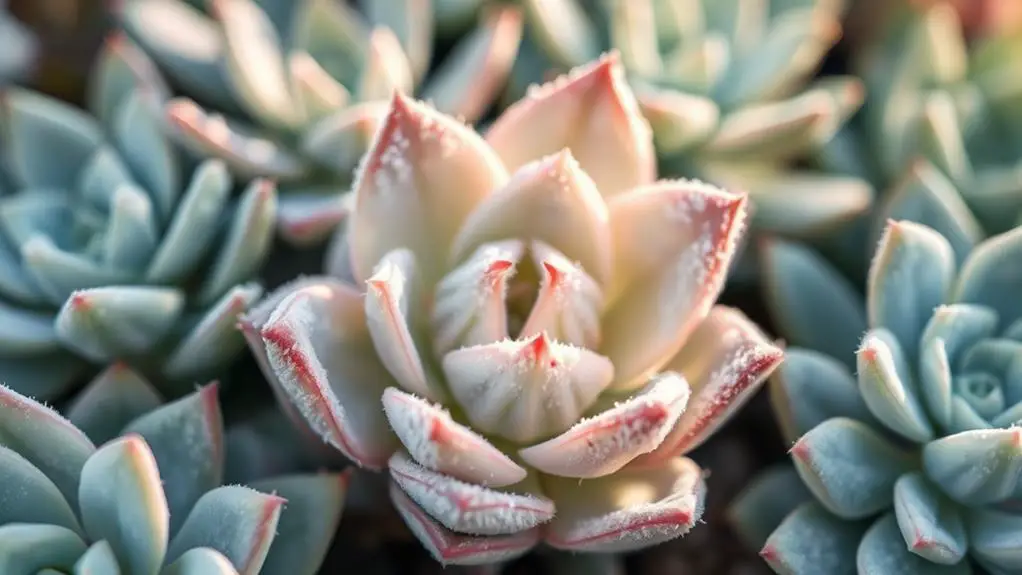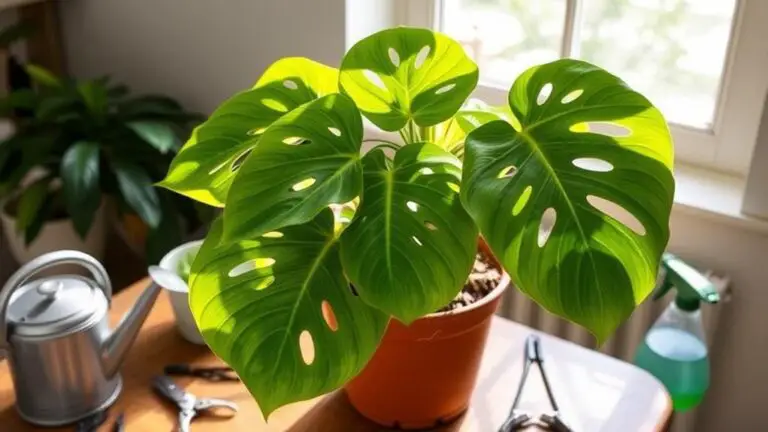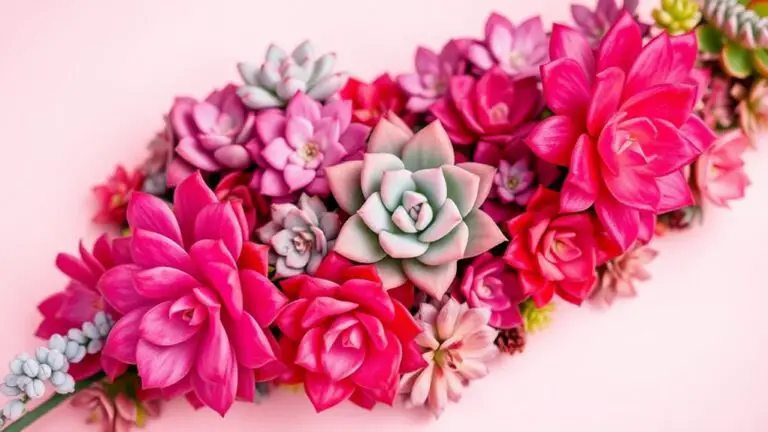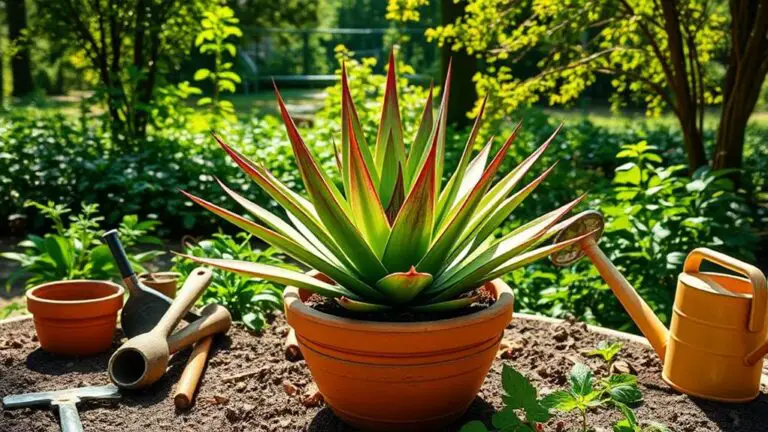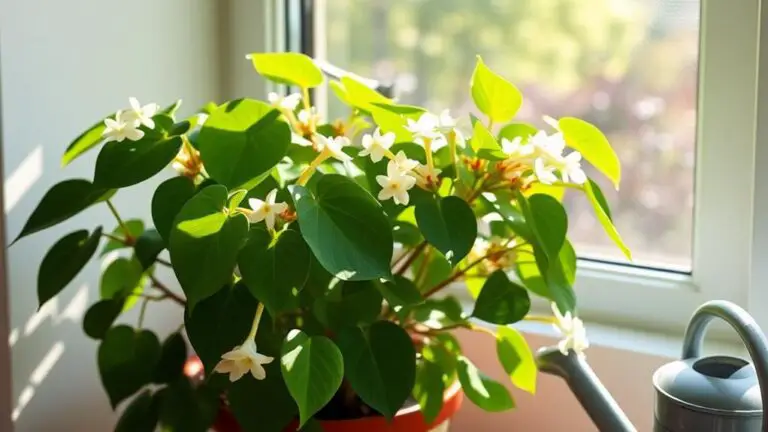Understanding Farina on Succulents – A How-To Guide
When you're caring for succulents, understanding the role of farina can greatly impact their health and appearance. This white, powdery coating isn't just for show; it's a protective barrier that shields your plants from harmful UV rays and excess moisture. Knowing how to handle your succulents to preserve this natural defense is vital. But why is it so important, and how can you guarantee you're not damaging this essential layer? Let's explore the benefits, handling tips, and cleaning techniques that will keep your succulents thriving and looking their best.
What Is Farina?
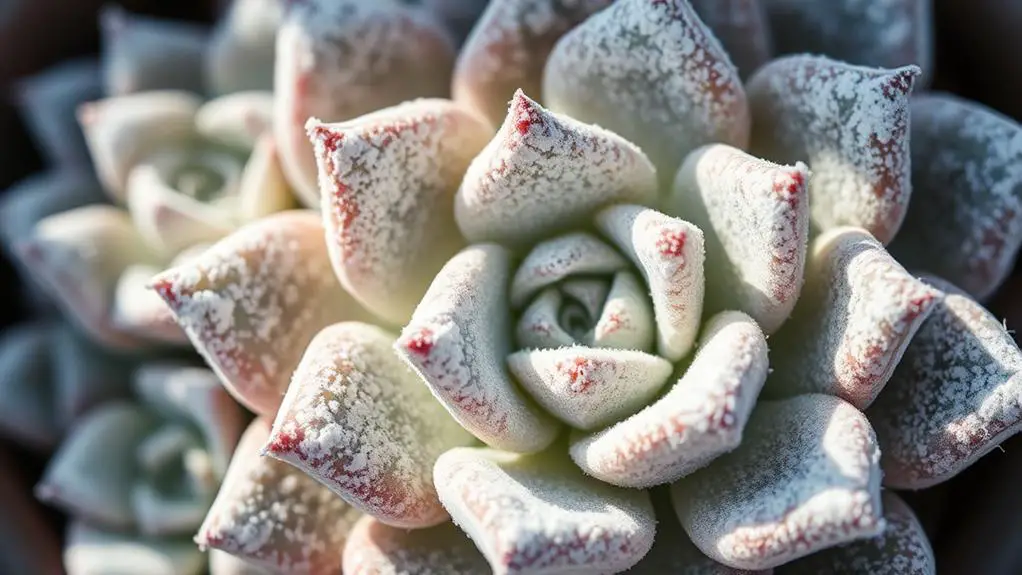
Farina, also known as epicuticular wax, is that white, powdery coating you often see on the stems and leaves of succulents. This protective coating isn't just for show; it plays an essential role in keeping succulent plants healthy.
Farina acts like a natural sunscreen by reflecting harmful UV rays. This helps prevent sunburn on the sensitive tissues of your succulents, guaranteeing they stay vibrant and healthy.
The waxy substance is also hydrophobic, meaning it repels water. This is especially important for succulents, which are adapted to arid environments. By repelling excess water, farina reduces the risk of root rot, a common problem for these plants.
So, when you see that powdery layer, know it's helping your plant thrive.
You'll find farina on many common succulent genera like Echeveria, Pachyphytum, Sedeveria, Kalanchoe, and Graptoveria. It gives them their distinctive look and indicates good health.
A uniform layer of farina means your plant is doing well. However, if the coating looks patchy or mottled, it might signal humidity issues or other stress factors. Keep an eye on it to guarantee your succulents stay in top shape.
Importance of Farina

When caring for your succulents, you'll quickly notice the significant role that farina plays. This waxy coating is more than just a pretty surface; it helps protect the plant in several essential ways. Farina acts as a hydrophobic layer, which means it repels excess water. This is important because it reduces the risk of root rot by maintaining a balanced moisture level.
The waxy coating also reflects harmful UV rays. This protection keeps succulent tissues safe from sunburn and heat stress, ensuring they thrive even in hot, arid environments.
Farina doesn't stop there—it serves as a physical barrier against pathogens and insect infestations. This added layer of defense enhances the overall health and resilience of your succulents.
An even coating of farina indicates good plant health. If you see a consistent layer, your succulent is effectively retaining moisture and protecting itself. However, if the farina is mottled or missing, it might signal humidity issues or disease.
Additionally, succulents with farina exhibit the Lotus Effect. Water beads on the surface, capturing dirt and microbes, which leads to cleaner leaves and boosts the plant's aesthetic appeal.
Benefits for Succulents

Understanding the importance of farina naturally leads us to appreciate its numerous benefits for succulents. Farina, a fine, powdery coating, acts as a protective barrier for your plants, offering several advantages that are vital for their health and beauty.
First, farina reflects harmful UV rays, preventing sunburn and ensuring your succulents thrive in bright environments. This is essential for their survival under intense sunlight.
Second, its hydrophobic nature helps conserve water by minimizing evaporation, making it easier for succulents to flourish in arid climates.
Finally, farina deters pests because its waxy texture makes it difficult for insects to latch onto the plant's surface, reducing the risk of infestations.
Here are some key benefits of farina:
- UV Protection: Shields succulents from harmful rays, preventing sunburn.
- Water Conservation: Reduces evaporation, helping plants thrive in dry conditions.
- Pest Deterrence: The waxy barrier makes it harder for pests to latch on.
Additionally, farina enhances disease resistance by preventing fungal infections, creating a physical barrier against pathogens.
Plus, succulents with a healthy layer of farina often look more appealing, showcasing a unique whitish or bluish-gray hue.
Embrace these benefits to keep your succulents healthy and stunning!
Handling and Maintenance
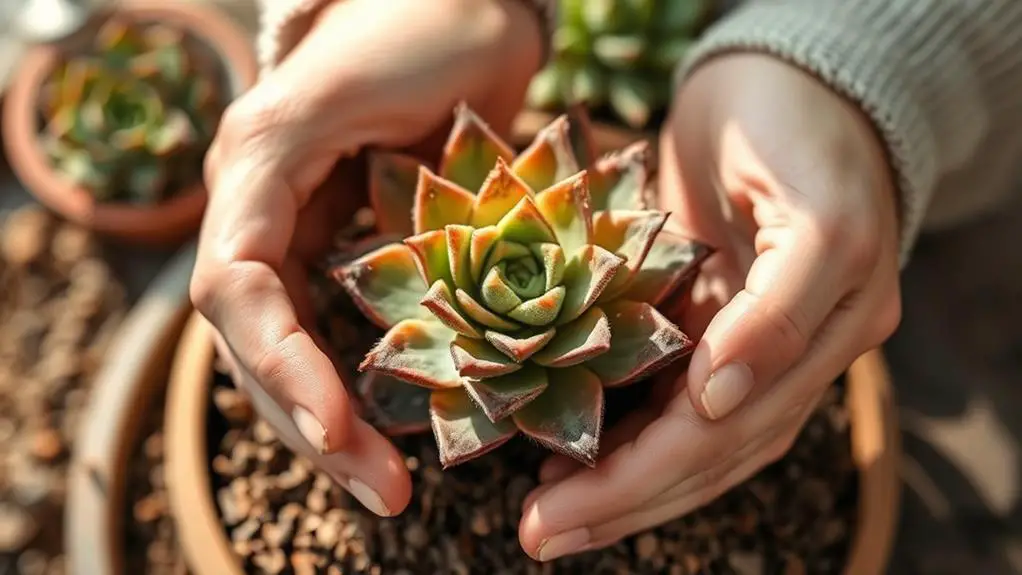
When handling your succulents, be gentle to avoid damaging the farina, which can easily be brushed off.
Use soft-bristled brushes, like makeup brushes, to clean your plants without removing this protective layer.
Also, keep an eye on your succulents for pests and diseases, as farina helps shield them, but once it's gone, they're more vulnerable.
Cleaning Techniques
To keep your succulents looking their best, focus on gentle cleaning techniques that preserve their delicate farina coating. The farina, a powdery substance on the leaves, helps protect your succulents from pests and disease, so maintaining it's essential.
Here's how to clean your succulents effectively:
- Soft-bristled brush: Use a makeup brush to gently remove dust and debris from the leaves. This prevents damage to the farina, keeping your succulents healthy and clean.
- Light blowing: Blowing lightly on the leaves can dislodge dirt without harming the farina. This method is simple and effective for regular maintenance.
- Avoid fingers: Don't use your fingers to wipe the leaves. Skin oils can strip away the farina, compromising the plant's natural protection.
If you find pests on your succulents, mist a rubbing alcohol solution onto the leaves. Be careful to avoid direct contact that could remove the farina.
Regularly inspect your succulents for signs of pests and diseases. Keeping the farina clean and intact helps prevent infestations and promotes overall plant health.
Handling Precautions
After mastering the cleaning techniques to preserve the farina on your succulents, it's equally important to handle them with care. The protective wax coating, known as farina, serves as a shield against sunburn and water damage. Here are some handling precautions to guarantee your succulents stay healthy.
First, always handle your succulents gently. Rough handling can remove the farina, leaving the plant vulnerable. Use soft tools, like a makeup brush or a gentle air blower, to clean dust off the leaves without disturbing the farina.
Avoid touching the leaves with bare hands. The oils from your skin can damage the delicate farina layer. When watering, make sure the soil dries completely between waterings to prevent rot, as farina helps regulate moisture retention.
Regularly inspect your succulents for pests and diseases. Use non-invasive treatments, like a rubbing alcohol mist, to avoid stripping away the farina.
Here's a quick reference table for handling precautions:
| Action | Tool/Method | Reason |
|---|---|---|
| Dusting leaves | Makeup brush, air blower | Avoid disturbing farina |
| Handling | Gloves or soft cloth | Prevent skin oil transfer |
| Watering | Dry soil between waterings | Prevent rot |
| Pest inspection | Visual check | Early detection |
| Pest treatment | Rubbing alcohol mist | Gentle on the farina |
Cleaning Techniques
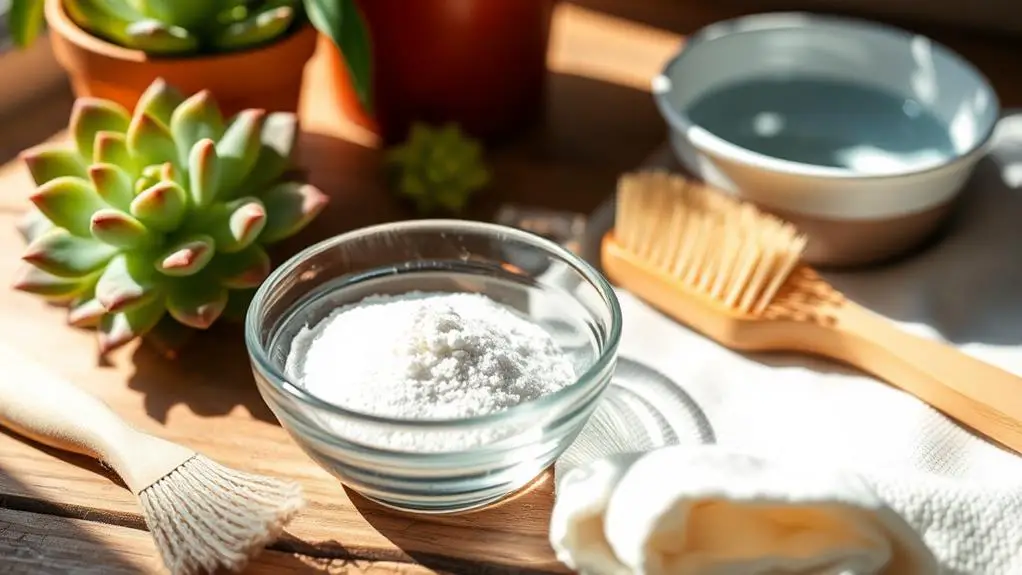
When cleaning your succulents, it's important to use gentle tools to protect their farina.
Try blowing off dirt from the leaves or using a soft-bristled brush, like a makeup brush, to sweep away debris without harming the protective coating.
For pest problems, misting a rubbing alcohol solution on the affected areas can help without damaging the farina.
Gentle Cleaning Tools
Maintaining the delicate farina on your succulents requires the right tools and techniques. Using gentle cleaning tools helps keep the farina coating intact, which is essential for protecting succulent leaves.
Here are some tools you'll find particularly effective:
- Soft-bristled brush: A makeup brush or a dedicated plant brush works wonders for removing dust and debris without damaging the farina.
- Blowing: Sometimes, the simplest method is the best. Blowing gently on the leaves can dislodge loose dirt without any abrasion risk.
- Damp microfiber cloth: For light cleaning, a slightly moist microfiber cloth can help. Just make sure it's barely damp to avoid stripping away the farina.
When using these tools, be sure to handle your succulents with care. Avoid paper towels or rough cloths, as these can scratch and remove the farina, exposing your plant to environmental stressors.
Remember, the goal is to keep the farina coating as undisturbed as possible while still keeping your succulents clean. By using the right tools and being gentle, you'll help your succulents thrive and look their best.
With these tips, you're well on your way to becoming a succulent care pro!
Safe Cleaning Methods
Guaranteeing your succulents stay clean without damaging the farina requires specific techniques that prioritize the plant's delicate nature. To safely clean the leaves, start by gently blowing away any loose dirt. This simple act minimizes abrasion and helps preserve the farina, which is vital for protecting your plant.
Sometimes, blowing isn't enough. For those stubborn bits of dust and debris, use a soft-bristled brush, like a makeup brush. Gently sweep the brush across the leaves to remove dirt without stripping away the farina. It's important to be gentle and avoid pressing too hard.
If you notice pests on your succulents, a light misting of rubbing alcohol can help. Carefully spray the affected areas, making sure not to overdo it. The goal is to treat the pests without harming the farina. Avoid using harsh chemicals or strong solvents, as these can damage the protective coating and compromise your plant's health.
Regular inspections are key. Keep an eye on your succulents to catch dirt and pests early. This proactive approach helps maintain the farina and guarantees your plants stay healthy.
With these safe cleaning methods, you can confidently care for your beautiful succulents.
Differentiating Mildew
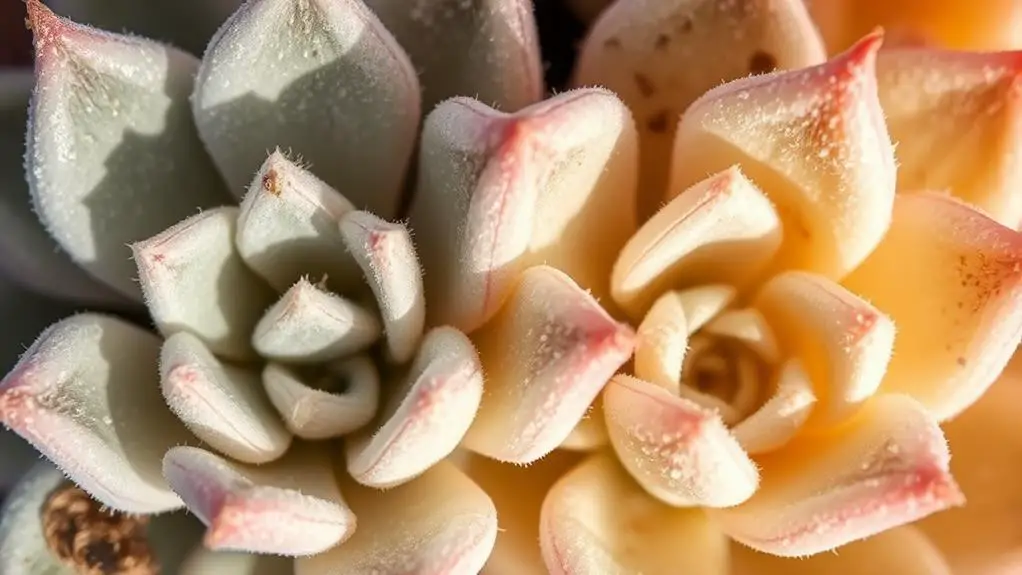
Distinguishing between farina and powdery mildew on succulents is essential for proper plant care.
Farina, a natural protective layer, appears as a smooth, even coating on the leaves. In contrast, powdery mildew has a patchy, fuzzy texture. To properly identify each, you need to rely on visual inspection. Farina will cover your plant uniformly, signaling health, while powdery mildew usually starts on one or two leaves and spreads unevenly.
When you're examining your succulents, keep these differences in mind:
- Texture: Farina is smooth and even, while powdery mildew is patchy and fuzzy.
- Coverage: Farina covers the entire plant from the start; powdery mildew begins on isolated leaves.
- Odor: Powdery mildew has a musty or sour smell; farina has no scent.
Common Succulent Varieties
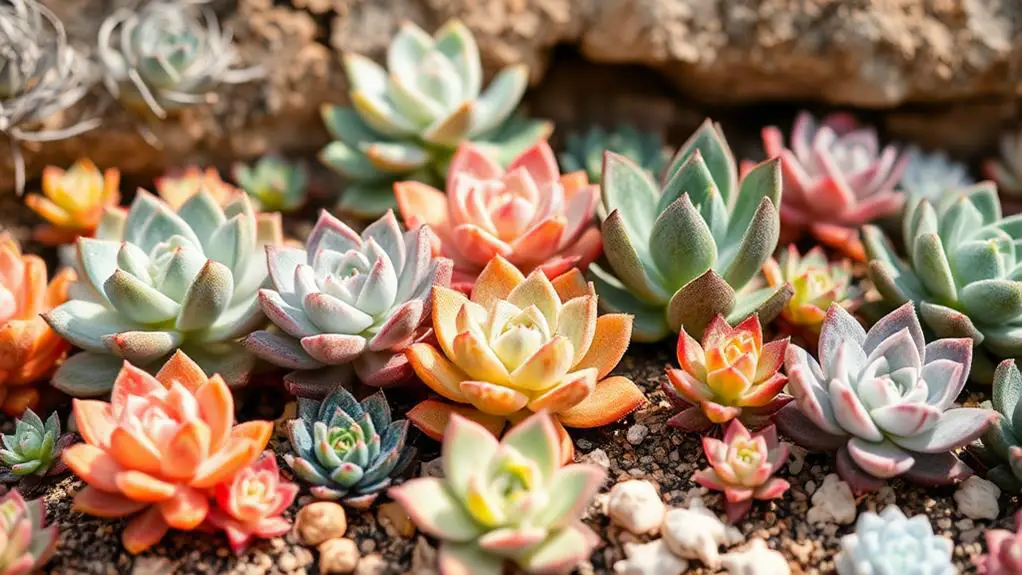
After understanding how to differentiate farina from powdery mildew, let's explore some common succulent varieties that showcase this unique feature.
One popular succulent is Echeveria. Known for its rosette shape and vibrant colors, Echeveria's farina enhances its beauty and provides protection against sunburn. This makes it both a stunning and resilient choice for your garden.
Next, consider Pachyphytum, often called the "pillow plant." Its thick, fleshy leaves are covered in farina, which helps retain moisture and resist pests. This makes Pachyphytum an excellent option if you're looking for a hardy plant that's easy to care for.
Sedeveria, a hybrid of Sedum and Echeveria, offers a range of colors and forms. Its farina acts as a protective shield against environmental stressors, making it a versatile addition to your succulent collection.
Kalanchoe is another great choice, especially if you love flowers. The farina on its leaves helps retain moisture and reflects harmful UV rays, promoting overall plant health.
Lastly, Graptoveria combines traits from Graptopetalum and Echeveria. Its farina enhances its striking appearance and serves as a defense against harsh conditions.
With these varieties, you'll have a beautiful and protected succulent garden.
Tips for Preservation
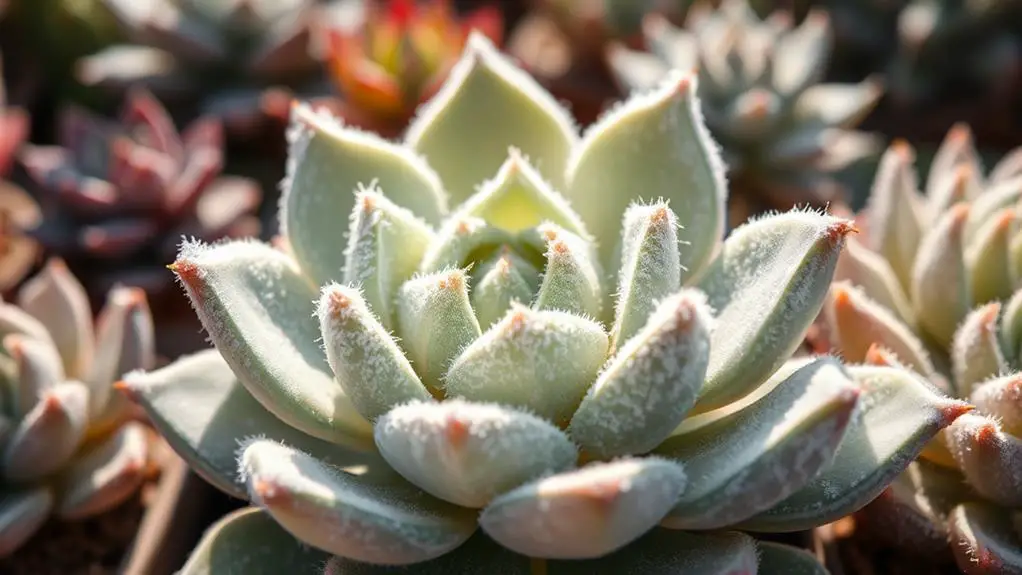
Preserving the delicate farina on your succulents requires some mindful handling. This protective layer is essential for your plant's health, so let's look at some practical tips to help you keep it intact.
First, always handle your succulents gently. Skin oils can damage the farina, so try to avoid touching the leaves.
If you need to clean your succulents:
- Use soft brushes: Gently brush off any dust or debris without disturbing the protective layer.
- Compressed air: A light burst can remove dirt without direct contact.
- Diluted rubbing alcohol: Treat pests carefully without disturbing the farina.
It's also important to keep your succulents in bright, indirect light. Direct sunlight can cause sunburn, which damages the farina. Keeping them in the right light will guarantee they stay healthy and their protective layer remains intact.
Avoid using pesticides or horticultural oils, as these can strip away the farina and expose your plant to environmental stress.
Instead, monitor your succulents regularly for pests and use safer alternatives like diluted rubbing alcohol.
Frequently Asked Questions
Does Farina Grow Back on Succulents?
Farina doesn't regenerate once removed, so handle your succulents carefully. New leaves might develop farina if the plant's healthy and environmental conditions are right. Regularly monitor and minimize handling to help preserve this protective barrier.
What Is Farina on Succulents?
Farina is a white, powdery coating on succulent leaves and stems. It protects your plants by reflecting UV rays and repelling water, reducing sunburn and root rot. It's common in Echeveria, Pachyphytum, and other genera.
What Is the Powdery Stuff on My Succulents?
The powdery stuff on your succulents is farina, a protective wax. It shields the plant from UV rays, retains moisture, and repels pests. Unlike powdery mildew, farina is even and odorless, enhancing your succulent's health and beauty.
What Is the White Powder Coating on Succulents?
The white powder coating on your succulents is called farina. It's a protective layer that acts like sunscreen, reducing water loss and preventing sunburn. Handle your succulents gently to avoid damaging this essential protective layer.
Conclusion
Taking care of your succulents' farina is key to keeping them healthy and beautiful. Remember, this special coating acts like sunscreen and helps prevent root rot. Handle your plants gently and inspect them often to keep the farina intact. Use soft brushes or air blowers for cleaning. By understanding and preserving farina, you'll help your succulents thrive. You're doing great—keep up the good work, and your plants will thank you!

